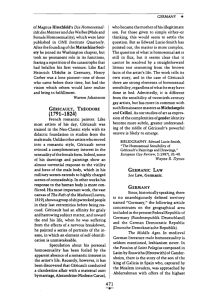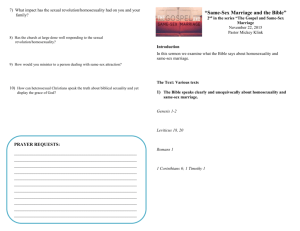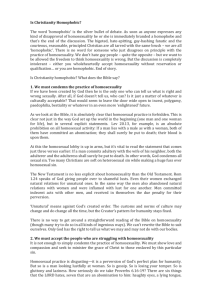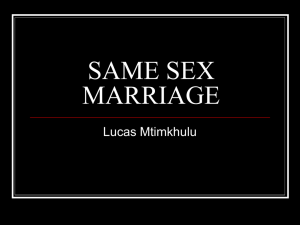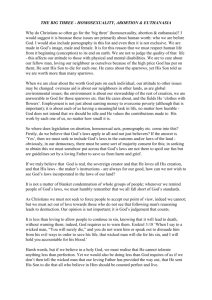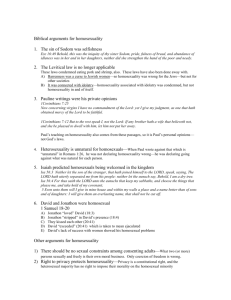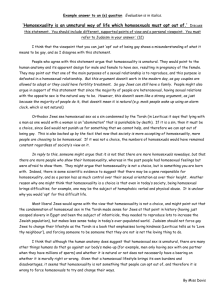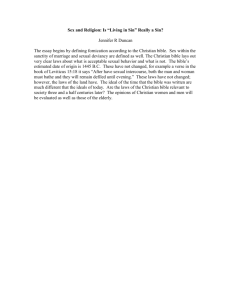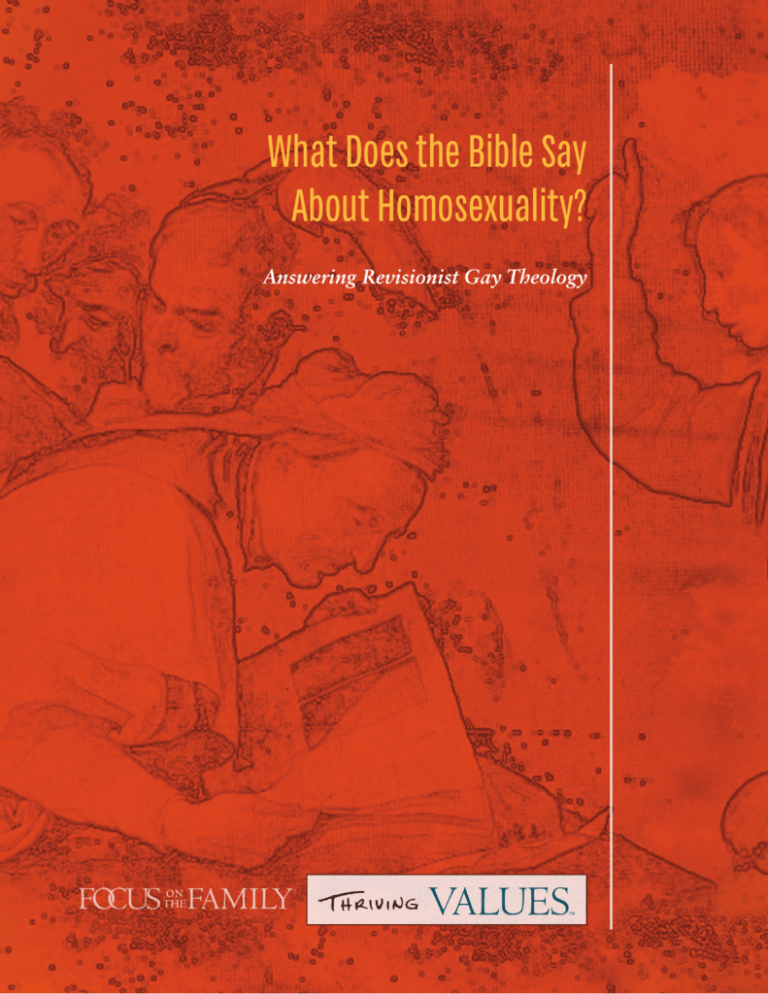
What Does the Bible Say
About Homosexuality?
Answering Revisionist Gay Theology
What Does the Bible Say?
Discussions of homosexuality or “same-sex marriage,” whether in person, in the
media or on the Internet, often turn to what the Bible says. Someone is likely to
argue that homosexuality is a sin and point to Leviticus, Romans or the Genesis
story of Sodom and Gomorrah. Others will suggest homosexuality is not a sin.
They’ll say things like, “Jesus never mentioned homosexuality” or “Eating shellfish
and wearing a shirt with two kinds of thread are also forbidden in Leviticus, but
you don’t follow those rules, do you?”
Other arguments get thrown into the mix—from both sides:
I heard that Jonathan and David were gay.
But God made Adam and Eve, didn’t He?
Sodom and Gomorrah were destroyed because of inhospitality, not homosexuality.
God says homosexuals won’t inherit the kingdom of God.
Paul didn’t understand homosexuality the way we do today—he was talking about
temple prostitution or child abuse.
Gays should be killed; it says so in Leviticus.
Jesus says not to judge people.
The discussion often becomes convoluted, incoherent or angry, degenerating into a
shouting match.
Perhaps you have participated in similar discussions—face to face or online. Maybe
you’ve seen these arguments or used them yourself. You may have found yourself
wrestling with doubts about the validity of your personal convictions and the
traditional Christian understanding of homosexuality and same-sex relationships.
If so, this booklet is for you.
God’s original design for human sexuality will be the starting point for this
discussion of Christian sexual ethics. We’ll look at some of the possible reasons
people might struggle with homosexuality. Then we’ll look at specific passages in
the Bible and respond to some of the revisionist arguments against the Church’s
traditional, biblical interpretation and teaching. And we’ll conclude with an
exhortation for Christians who engage in this discussion.
Why this matters: understanding the times
Along with the broader sexual revolution that began to develop during the ’50s
and ‘60s, a strong activist movement has worked to create new categories of “civil
rights” defined by “sexual orientation,” a vague term which can include sexual
and romantic attractions, identity or behavior. Currently, this homosexual activist
2
What Does the Bible Say?
ideology has significantly influenced every area of our culture—including a segment
of the Church.
Just think about our entertainment, where homosexual characters
and dialogue are commonplace in movies and on TV. In fact,
lesbian-, gay- and bisexual-identified (LGB) characters probably
outnumber positive portrayals of Christians, who actually comprise
a much larger percentage of the population. In the news media,
those who oppose marriage redefinition are often given negative
labels such as “anti-gay,” “bigoted” or “anti-equality.”
Curricula and literature affirming homosexuality have made
their way into public schools, even for kids in kindergarten! Both
business and government sectors have been pressured into offering
same-sex benefits and “diversity” training for their employees.
Several mainline denominations now allow the blessing of
homosexual unions and the ordination of gays and lesbians.
It’s
vital that
Christians
step up and
present a
vision of
God’s positive
Yet the responsibility can’t be placed entirely on the shoulders
of the gay-activist movement. Many churches and Christians are
accountable for not only failing to uphold and proclaim a vibrant,
biblical sexual ethic, but also for failing to walk alongside those
struggling with homosexuality, offering love, encouragement and support.
design.
As a result, many inside and outside the body of Christ have looked to the secular
culture for answers. As our society becomes more sexualized and secularized, it’s
vital that Christians step up and present a vision of God’s positive and life-affirming
design for marriage between one man and one woman.
Homosexual activism in the church
Regardless of who we are or where we’ve come from, God has placed a longing
for Himself within each of us. This desire can be particularly strong in those who
have experienced pain, rejection and abandonment, especially from their fathers,
mothers, siblings or peer group. For many, unmet needs, peer-group rejection or
familial wounds are significant factors in their homosexuality. This hunger has driven
LGB-identified men and women who are hungry for God—and who may have also
experienced rejection from Christians—to start their own churches, construct their
own theologies or join religious groups that affirm their sexual identity.
3
What Does the Bible Say?
Aside from their stand on sexuality, many churches or denominations that have
revised theology to accommodate or even celebrate homosexual behavior may look
similar to evangelical churches: Hands are raised in worship; God’s name is invoked
during prayer; children are dropped off at Sunday school; notes are scribbled on
well-worn Bibles during sermons.
Although they may be well-meaning, sorely misguided activists and their allies have
twisted the biblical narrative on sexuality and created their own “revisionist gay
theology.” In doing so, they have sought to present an image of God who not only
accepts same-sex sexual behavior, but has offered it to them as a gift. One leader in
the revisionist gay movement tells those who struggle with homosexuality that his
own homosexuality “is a gift from my Creator to be accepted and celebrated and
lived with integrity.”1
Christians must be equipped to respond with grace and truth.
God’s original intent
God isn’t silent about human sexuality. The Bible has many passages addressing
the beauty, power, wonder and purposes of sex. Like any good gift, sex may be
misused, so the Bible also gives guidance about this, as well.
Looking at the whole of Scripture, we find a comprehensive, rich picture of human
sexuality. The story begins with God creating humanity in His image, male and
female. Two distinct but complementary creatures, made for each other. Together,
man and woman were fashioned to reflect the image and likeness of God.
Exploring this design for human sexuality a little further, Glenn Stanton, director of
global family formation studies at Focus on the Family, says:
Male and female, together, are the fullest picture of the image of God in
creation. That’s why they need each other. Adam wasn’t complete without Eve.
In everyday terms, this means that only the difference and the complementary
interplay of male and female uniquely reflect the image and likeness of the
persons of the Trinity in creation. As a result, sexual love between married
man and woman is a life-giving act of mutual giving and receiving that
mirrors the Trinity like nothing else on earth.2
Marriage, the husband-wife relationship, is a major theme of Scripture, from
beginning to end. Genesis starts with this union of Adam and Eve; the Song of
Solomon celebrates marriage and human sexuality; and the book of Revelation
4
What Does the Bible Say?
ends with the wedding feast of Christ and his bride.
In Genesis, God declares His purpose for Adam and Eve, that they
unite together in marriage and “be fruitful and multiply” (Genesis
1:28). Stanton also notes that God designed this marriage union to
be permanent, committed, exclusive and self-giving.3 It is a complete
union—emotional, spiritual and physical—with the possibility of
producing new life (Genesis 2:23-24).
As C.S. Lewis writes of the marital union:
The Christian idea of marriage is based on Christ’s words that a
man and wife are to be regarded as a single organism—for that is
what the words “one flesh” would be in modern English. And the
Christians believe that when He said this He was not expressing a
sentiment but stating a fact—just as one is stating a fact when one
says that a lock and its key are one mechanism, or that a violin
and a bow are one musical instrument. The inventor of the human
machine was telling us that its two halves, the male and the female,
were made to be combined together in pairs, not simply on a
sexual level, but totally combined.4
Christians
must be
equipped
to respond
with
grace
and
truth.
Because this relationship is so central to creation and humanity, God’s heart for
marriage is woven throughout the Old and New Testaments. Marriage is the most
important picture in Scripture of our own relationship with God. God is portrayed
as a husband, and His wife is the nation of Israel. She is unfaithful, but still His
own, and He lovingly pursues her. And the Church is the Bride of Christ, who
sacrificed himself for her.
A Christian sexual ethic
The Bible, beginning with the Genesis account of creation, provides rich insight
into how the lives of men and women living together in a holy covenant cannot
be matched by any other “union.” God intended sex to be part of the marriage
relationship—and only that relationship.
Sadly, Adam and Eve fell into sin, and their sin affected each one of us, as well as
every part of us—including our sexuality and relationships. Any kind of relational
sin, whether envy, lies, hatred, violence, rage, gossip or disobedience to authority,
falls short of God’s design. And any kind of sexual sin—whether sex outside of
marriage, pornography, homosexuality, rape, lust or fantasy—all falls short of God’s
5
What Does the Bible Say?
design of the union of a husband and wife.
Any sex outside of a husband-and-wife relationship is not God’s plan. “According
to the biblical understanding, sexual intercourse is connected to the coming
together of two persons as sexual beings into one-flesh union,” says Stanley J.
Grenz, a theologian and author of the book Welcoming But Not Affirming. “It
represents the act of two-becoming-one at the deepest level of their being (e.g.
Genesis 2:23-34; Matthew 19:4-6).”5
Regarding homosexual behavior, Grenz continues:
… same-sex intercourse loses the symbiotic dimension of two-becomingone present in male-female sex. At best, it is only a simulation of the twobecoming-one ritual the act of sexual intercourse is designed to be.6
Homosexuality is particularly egregious because it rejects God’s design at its
deepest point: Male and female were created for each other and together reflect the
image of God. Same-sex relationships imply that the unique attributes both male
and female bring to the table don’t make much difference, that man and woman are
virtually interchangeable.
In recent years there have been zealous attempts to redefine and reinterpret
particular biblical passages. But the true intent of the biblical narrative—from
Genesis to Revelation, taught and affirmed by Moses, Christ and Paul, and
espoused in both Judaism and Christianity for thousands of years—cannot be
denied, changed or twisted to fit a different sexual agenda.
Our goal in writing this booklet is not to bash people, but to speak clearly the truth
of Scripture: sexual activity is reserved for marriage between a husband and wife;
sexuality outside of those boundaries, including homosexuality, is a sin. Those who
deny the sin of homosexual behavior are actually denying people God’s forgiveness,
grace and salvation.
Factors in homosexual struggles
Why are some individuals attracted sexually (either exclusively or secondarily) to
their own gender?
Honestly, Scripture is silent about this, except for the general teaching in Romans 1
that all of us are subject to the consequences of the Fall—when Adam and Eve,
6
What Does the Bible Say?
as representatives of humanity, turned away from God. So we are born into a
world where some will struggle with homosexuality, while others will struggle
with different temptations and sins. And different cultures may also replicate the
downward spiral, moving further away from God and His truth that is described in
Romans 1. As Pastor Sam Allberry explains:
It is important to recognize that Paul is talking in societal rather
than individual terms. He is describing what happens to culture
as a whole, rather than particular people. The presence of samesex desire in some of us is not an indication that an individual
has turned from God more than others, or that they have been
given over by God to further sin more than others.
There is a parallel with suffering. The presence of particular
suffering in someone’s life does not mean they’ve sinned more
than someone suffering less.7
Not only are we subject to Adam’s sin and born into a sinful world,
but the Bible also teaches that each one of us has turned away from
God. Both the Old and New Testaments describe the darkness inside
the human heart. Passages like Isaiah 53, Psalm 14 and Romans 1-3
testify to what Dallas Willard calls “radical evil in the ruined soul.”8
The presence
of particular
suffering …
does not
mean they’ve
sinned
more than
someone
suffering
less.
Because of our individual and collective rejection of God, we are
vulnerable to a wide variety of sins, including homosexuality. We
could ask the same question about any of the sins listed in Romans 1:
Why are some individuals more prone to gossip? Why do some people struggle with
lust? Or others with greed or pride or disobeying their parents?
Where the Bible is silent, we must be careful not to be too dogmatic. The reasons
why some people struggle with same-sex attractions are probably different for
each person. However, there are some recurring patterns and factors in many who
struggle with same-sex attractions.
For example, therapists and ministry leaders have noted that for some people
homosexuality is a condition whereby a person attempts to fulfill sexual, romantic
or emotional needs and desires through a member of the same sex. As Frank
Worthen of New Hope Ministries says, “Homosexuality is a misguided search
for love and affirmation. It’s a break in the relational bonds within the family,
producing a lack of a sense of belonging or a lack of affirmation.”9
7
What Does the Bible Say?
In other words, same-sex erotic or romantic attractions may develop as an
unconscious attempt to meet legitimate needs for intimacy or repair breaks in
foundational relationships. This theory resonates with many who struggle with
unwanted homosexual attractions.
Another factor in homosexuality may be childhood sexual abuse or exposure to
pornography. Childhood sexual abuse is higher in men who have sex with men than
in the general male population,10 and such incidents seem to be a factor in many
who struggle with homosexuality, creating confusion about sex and sexuality. In
addition, sexual behavior is highly addictive, and for many, homosexual behavior
has this addictive component.
Counselor and author Janelle Hallmen notes that many women who struggle with
lesbianism did not conform as much with gender norms when they were younger.
As a result, some experienced more difficulty embracing and integrating their
femininity.11 Childhood gender confusion may also be a factor for men with samesex attractions. These are just a few of the possible developmental and relational
factors that might influence someone toward homosexuality.12
When churches revise theology to embrace same-sex sexual intimacy, they add
to the confusion already prevalent in our world. Instead of offering healing and
transformation, they compound the deception and dysfunction and promote false
intimacy and sinful behavior. In attempting to meet a homosexual’s deep hunger
for God the Father, they discount biblical truth and reject historic Church teaching,
which calls all of us to confession and repentance. They deny those struggling with
same-sex attractions forgiveness, grace, healing and restoration. This false teaching
should compel believers to reach out to those struggling with homosexuality with
the compassion of Christ and the truth of God’s Word.
Answering revisionist gay theology
God’s design for human sexuality and marriage are clear, so how do gay revisionist
theologians support their position? How do they use Scripture? If we are serious
about reaching out to homosexuals in truth and love, we will have to understand
and address this revisionist theology.
Typically, theological revisionists don’t address our starting point and
strongest argument: God designed sexual relationships for one woman
and one man in a marriage. Nor do they spend much time on the fact that
Moses, Paul and Jesus affirmed and taught this truth, or that for 2,000 years
the Church has taught this. Instead, they attempt to re-interpret various
8
What Does the Bible Say?
Scriptures that address and condemn same-sex sexual behavior.
As someone who used to identify as gay, Joe Dallas is a counselor, teacher and
author who explains that we must be prepared to answer revisionist arguments:
[Revisionist gay] theology offers what appears to be a series of conservative,
fundamentalist responses to conservative, fundamentalist objections. That is,
it meets every Bible verse referring to homosexuality head on, and attempts to
explain why each verse is misunderstood today. Common sense may reject it,
but until it is examined a bit more closely, it is difficult to refute.13
Difficult—perhaps. But not impossible. We can respond effectively to this particular
brand of Scripture-twisting, if we do our homework. Let’s take a closer look at the
relevant biblical passages, the assertions of homosexual revisionist scholars and
some suggested responses.
Some portions of the following sections of Argument and Response are taken from
Joe Dallas’ A Strong Delusion: Confronting the “Gay Christian” Movement.14
Two other helpful books are Is God Anti-Gay? (Questions Christians Ask),
by Sam Allberry, and the scholarly work The Bible and Homosexual Practice:
Texts and Hermeneutics, by Robert A. J. Gagnon.
Before we begin, we want to make an important distinction. Homosexuality is
comprised of many aspects, including these three: attractions, behavior and identity.
We make a distinction between the three and note that only same-sex behavior and
lust, and acting like the opposite sex are condemned in Scripture. So when the Bible
uses words like “abomination,” or “detestable,” it is not talking about people, but
about behaviors, things people do. We regret that such words have been used to
describe individuals.
The Creation account
Genesis 1:27
So God created man in his own image,
in the image of God he created him;
male and female he created them.
9
What Does the Bible Say?
Genesis 2:20-24
The man gave names to all livestock and to the birds of the heavens and to
every beast of the field. But for Adam there was not found a helper fit for
him. So the Lord God caused a deep sleep to fall upon the man, and while
he slept took one of his ribs and closed up its place with flesh. And the
rib that the Lord God had taken from the man he made into a woman and
brought her to the man. Then the man said,
“This at last is bone of my bones
and flesh of my flesh;
she shall be called Woman,
because she was taken out of Man.”
Therefore a man shall leave his father and his mother and hold fast to his
wife, and they shall become one flesh. Revisionist Argument: The Genesis account does not forbid homosexuality; it
simply does not refer to it.
Response: While it is true this passage does not forbid homosexual relations,
it does provide the model, the standard, for human sexuality. The male-female
marriage union, introduced in Genesis, is the only type of sexual behavior
consistently praised in both Old and New Testaments. Moses, Jesus and Paul each
point to Genesis as the primary text for understanding God’s design in creation.
We must look at all forms of sexual expression through the lens of marriage and
the male/female complementarity of God’s design in Genesis. Dr. Robert Gagnon,
one of the world’s foremost scholars on homosexuality, writes about how God
brings forth the woman from the man, creating a longing within them to reunite
through marriage and sexual intercourse. “The woman is not just ‘like himself’ but
‘from himself’ and thereby a complementary fit to himself. She is a complementary
sexual ‘other.’”15
Gagnon explains how this teaching from Genesis permeates Scripture. All through
10
What Does the Bible Say?
the Bible, men and women are presented as biologically complementary for the
purposes of sexual activity and reproduction. This complementarity is “clear and
convincing proof of God’s will for sexual unions.” Echoing Paul in the book of
Romans, he continues by saying that even those who don’t believe the Bible should
be able to figure out God’s design because of the physical structure of created
humanity.16
The destruction of Sodom
Genesis 19:4-9
[T]he men of the city, the men of Sodom, both young and old, all the
people to the last man, surrounded the house. And they called to Lot,
“Where are the men who came to you tonight? Bring them out to us,
that we may know them.” Lot went out to the men at the entrance,
shut the door after him, and said, “I beg you, my brothers, do not act so
wickedly. Behold, I have two daughters who have not known any man. Let
me bring them out to you, and do to them as you please. Only do nothing
to these men, for they have come under the shelter of my roof.” But they
said, “Stand back!” And they said, “This fellow came to sojourn, and he
has become the judge! Now we will deal worse with you than with them.”
Then they pressed hard against the man Lot, and drew near to break the
door down.
Revisionist Argument #1: Sodom was destroyed because of the inhospitality of
its citizens, not because of homosexuality.
Response: The argument makes no sense in light of Lot’s words and actions. His
first response, “Don’t do this wicked thing,” could hardly apply to a simple request
to “get to know” his guests. The second thing Lot does is especially telling: He
answered the demands of the men of the city by offering his two virgin daughters—
another senseless gesture if the men wanted only a social knowledge of his guests.
Surely the people of the town were acquainted with Lot’s daughters, and Lot’s
response makes clear that he and the townsmen are talking about sexual activity.
11
What Does the Bible Say?
Revisionist Argument #2: Sodom was destroyed for attempted rape, not
homosexuality.
Response: The argument is partially true; the men of Sodom certainly were
proposing rape. But for such an event to include “all the men from every part of the
city of Sodom—both young and old,” homosexuality must have been commonly
practiced.
Professor Thomas Schmidt, in his book, Straight and Narrow? Compassion and
Clarity in the Homosexuality Debate, cites evidence in early literature connecting
Sodom with more general homosexual practices. The literature says the people of
Sodom were “sexually promiscuous” and “departed from the order of nature.”17
Here “the order of nature” is a reference to male-female complementarity.
Revisionist Argument #3: The real sins of Sodom, according to Ezekiel 16:49,
were “pride, excess of food, and prosperous ease, but did not aid the poor and
needy.” These have nothing to do with homosexuality.
Response: Again, the argument is partially true. When Sodom was destroyed,
homosexuality was one aspect of its wickedness. But Ezekiel also says of the
city: “They were haughty and did an abomination before me” (16:50). When we
read 2 Peter 2:6-7 and Jude 7, we learn that this “abomination” included sexual
immorality and homosexual conduct.
The Holiness Code
Leviticus 18:2b-3, 22; 20:13
I am the Lord your God. You shall not do as they do in the land of Egypt, where
you lived, and you shall not do as they do in the land of Canaan, to which I am
bringing you. You shall not walk in their statutes. …
You shall not lie with a male as with a woman; it is an abomination
[abhorrence].
If a man lies with a male as with a woman, both of them have committed an
abomination; they shall surely be put to death; their blood is upon them. 12
What Does the Bible Say?
Revisionist Argument #1: The practices mentioned in these chapters of
Leviticus have to do with idolatry, not homosexuality.
Response: The prohibitions against homosexuality in Leviticus 18
and 20 appear within lists of other sexual sins—adultery and incest,
for example—which are forbidden in both Old and New Testaments.
If the practices in Leviticus 18 and 20 are condemned only because of
their association with idolatry, then it logically follows they would be
permissible if they were committed apart from idolatry. That would
mean incest, adultery, bestiality, and child sacrifice (all of which are
listed in these chapters) are only condemned when associated with
idolatry; otherwise, they are allowable. No serious reader of these
passages could accept such a premise.
Revisionist Argument #2: The Holiness Code’s injunction
against homosexual acts is not an ethical but rather a ceremonial
prohibition. It focuses on Jewish ritual cleanness, not Christian
behavior.
Response: This argument, too, is based on a partial truth. New
Testament scholar Stanley Grenz says:
Typically, when
the Bible uses
words like
“abomination,”
or “detestable,”
it is not
talking about
people, but
about actions,
what people do.
This theory is a helpful reminder that the Holiness Code
arose partly out of a concern for ritual purity. However, it is
not completely clear that the injunctions against sex acts such as bestiality
and same-sex intercourse fall in this category. … Further, by claiming that
the Holiness Code prohibition of homosexual acts arises merely out of
concern for ceremonial purity and not for morality, the argument assumes a
disjunction between ethics and ritual uncleanness that is foreign to Leviticus.
… Considerations such as these make it difficult to get around the conclusion
that the Holiness Code prohibits homosexual acts in general and that it did so
on the basis of concerns that were at least in part moral.18
Revisionist Argument #3: You don’t follow all of Leviticus, you eat shellfish
and wear mixed threads, don’t you? Those are prohibited in the same passages as
the verses on homosexuality.
Response: Of course, sexual activity is a much bigger deal than eating shrimp or
wearing a polyester-cotton blend shirt. They are not equivalent. In addition, we
don’t throw out other sexual ethics in Leviticus 18 and 20 such as the prohibitions
against incest or adultery.
13
What Does the Bible Say?
Dr. Michael Brown, author and theologian, helps explain the difference between
dietary laws that applied to Israel and ethical laws that apply to everyone:
Within the Torah (God’s Teaching and Law), there were many laws given to
Israel to keep them separate from the nations (like Leviticus 19:19). That’s
why the Torah said that certain foods, like shellfish, were unclean for the
Israelites but not for all people (see Deuteronomy 14:7, 19). On the other
hand, there were laws given to Israel that were universal in scope, like the
command not to murder.
When it comes to homosexual practice, not only is it the only sinful action
singled out in Leviticus as an abomination, but it is part of a list of universal
moral prohibitions, including incest and other forbidden sexual acts. We
know this because the chapter states that the Lord judged the pagan nations
for these very acts, and if acts were wrong for idol-worshiping pagans, they
were wrong for the people of Israel (see Leviticus 18:24-30). And when we
see that the prohibition against homosexual practice is reiterated in the New
Testament, the case is settled for those who accept the Bible as God’s Word.19
David and Jonathan
1 Samuel 19:1
And Saul spoke to Jonathan his son and to all his servants, that they
should kill David. But Jonathan, Saul’s son, delighted much in David.
2 Samuel 1:25-26
[David is lamenting the deaths of Saul and Jonathan.]
Jonathan lies slain on your high places.
I am distressed for you, my brother Jonathan;
very pleasant have you been to me;
your love to me was extraordinary,
surpassing the love of women.
14
What Does the Bible Say?
Revisionist Argument: David and Jonathan were obviously homosexual lovers.
Response: Given the evidence of the biblical text, the conclusion is anything
but obvious. Instead, this interpretation reflects a set of cultural assumptions—in
particular, a highly sexualized interpretation of the word “love”—which is more
characteristic of modern Western society than of the ancient Near East. Contrary to
the implications of contemporary movie plots and song lyrics, “love” and “sex” are
not mutually interchangeable terms. They certainly weren’t in biblical times, and we
shouldn’t impose our worldview on ancient times.
Demonstrative, emotionally charged same-sex friendships were common in
David and Jonathan’s cultural context. Theologian Stanley Grenz notes that the
language of David’s lament is typical of that used in treaties. In this case, it’s as
if David were describing or establishing a treaty between himself and Jonathan’s
family. Grenz also notes that both David and Jonathan married women and
fathered children.20
The Bible does not avoid David’s sins—including pointing out his orchestration of
the murder of Uriah and his adultery with Bathsheba (II Samuel 11-12). If David
had sinned homosexually, certainly Scripture would have noted it, and he might
have incurred the penalty for such activity.
Plural marriage in Scripture
Revisionist Argument: Many in the Bible, including Abraham and David,
practiced polygamy. Why aren’t you open to practicing polygamy and other types of
sexual relationships?
Response: The Bible is honest about sexual sin in a fallen world and describes
many kinds of sexual activity, including polygamy, incest, prostitution, rape and
homosexuality, all of which are rejected as God’s design. But the only kind of sexual
behavior the Bible prescribes is marriage between one man and one woman.
Jesus
Revisionist Argument: Jesus never taught against homosexuality or lesbianism.
In fact, He was silent on the issue.
Response #1: As Grenz writes:
15
What Does the Bible Say?
{A}rguments from silence are notoriously difficult to substantiate. We might
just as easily conclude that other acts about which Jesus was silent were equally
unimportant to the Master. For example, does His silence about incest mean
that we are no longer bound to the Old Testament prohibitions in this area?21
There is a much simpler and more obvious explanation for Jesus’ silence. It was not
a controversial issue of that period. It was a settled issue in Israel that homosexual
behavior was a sin, so Jesus was not asked about it.
Response #2: Jesus is the Son of God; He is the living Word, God made flesh.
The revisionist argument assumes that Jesus somehow might have had a different
view of homosexuality from that which was made clear to God’s people in the Old
Testament. Jesus is one with the Father, and the Spirit, and the same Holy Spirit
inspired all the authors of Scripture. Jesus kept and affirmed all that the Law and
the Prophets taught (Matthew 5:17-19).
Response #3: Jesus said everything that needed to be said on the subject of sexual
ethics when He quoted Genesis in response to the Pharisees’ question about divorce:
He answered, “Have you not read that he who created them from the
beginning made them male and female, and said, ‘Therefore a man shall leave
his father and his mother and hold fast to his wife, and the two shall become
one flesh’? So they are no longer two but one flesh. What therefore God has
joined together, let not man separate.” (Matthew 19:4-6)
In other words, Jesus explicitly endorsed the Christian sexual ethic outlined earlier
in this booklet. As Grenz affirms:
But nowhere did [Jesus] condone genital sexual activity outside the context
of a lifelong heterosexual commitment. In fact, the only option He mentioned
other than marriage was celibacy (Matthew 19:11-12). Moreover, whenever
Jesus engaged with questions involving human sexual conduct, he appealed to
God’s intention in creation (e.g., Mark 10:11-12; Matthew 19:4-9).22
Paul: ‘natural’ and ‘unnatural’
Romans 1:18-27
For the wrath of God is revealed from heaven against all ungodliness and
unrighteousness of men, who by their unrighteousness suppress the truth. For what
can be known about God is plain to them, because God has shown it to them.
16
What Does the Bible Say?
For his invisible attributes, namely, his eternal power and divine nature, have
been clearly perceived, ever since the creation of the world, in the things that
have been made. So they are without excuse. For although they knew God,
they did not honor him as God or give thanks to him, but they became futile in
their thinking, and their foolish hearts were darkened. Claiming to be wise,
they became fools, and exchanged the glory of the immortal God for images
resembling mortal man and birds and animals and creeping things.
Therefore God gave them up in the lusts of their hearts to impurity, to the
dishonoring of their bodies among themselves, because they exchanged the
truth about God for a lie and worshiped and served the creature rather than the
Creator, who is blessed forever! Amen.
For this reason God gave them up to dishonorable passions. For their women
exchanged natural relations for those that are contrary to nature; and the
men likewise gave up natural relations with women and were consumed
with passion for one another, men committing shameless acts with men and
receiving in themselves the due penalty for their error.
Revisionist Argument #1: Paul is not describing true homosexuals; rather, he is
referring to heterosexuals who, as he says, “exchanged natural relations.” The real
sin here is in changing what is natural to the individual.
Response: There is nothing in Paul’s wording to suggest he even recognized such
a thing as a “true” homosexual versus a “false” one. The idea of gay as an identity,
of someone “being gay” or “being homosexual” is a modern construct, rooted in
ideology and a particular worldview. Paul simply describes homosexual behavior as
against nature—unnatural.
Paul’s wording, in fact, is unusually specific. He chooses the Greek words that most
emphasize biology. He is not considering any such thing as sexual orientation.
He is saying that homosexuality is biologically unnatural—not just unnatural to
“heterosexuals,” but unnatural to anyone. As Grenz puts it, “The verse does not
speak of natural and unnatural feelings, but natural and unnatural function.”23 Paul
17
What Does the Bible Say?
is speaking of how we are created—male and female.
Revisionist Argument #2: This Scripture describes people given over to
idolatry, not gay Christians who worship the true God.
Response: Idolatry plays a major role in Romans 1. Paul begins his writing by
describing humanity’s rebellion and decision to worship creation rather than
the Creator. But Paul is also talking about sins that arise when humanity stops
worshiping the true God, including the sin of homosexual sexual activity. Professor
Schmidt explains:
Paul is not suggesting that a person worships an idol and decides therefore to
engage in same-sex relations. Rather, he is suggesting that the general rebellion
created the environment for the specific rebellion: “For this reason God gave
them up to,” not “As a result of this they did.”24
Paul: the rejection of same-sex acts
1 Corinthians 6:9-10
Or do you not know that the unrighteous will not inherit the
kingdom of God? Do not be deceived: neither the sexually
immoral, nor idolaters, nor adulterers, nor men who practice
homosexuality, nor thieves, nor the greedy, nor drunkards,
nor revilers, nor swindlers will inherit the kingdom of God.
And such were some of you. But you were washed, you were
sanctified, you were justified in the name of the Lord Jesus
Christ and by the Spirit of our God.
1 Timothy 1:9-10
Now we know that the law is good, if on
e uses it
lawfully, understanding this, that the law
is not laid down for the
just but for the lawless and disobedient,
for the ungodly and sinners,
for the unholy and profane, for those wh
o strike their fathers and
mothers, for murderers, the sexually im
moral, men who practice
homosexuality, enslavers, liars, perjurers
, and whatever else is
contrary to sound doctrine. …
18
What Does the Bible Say?
Revisionist Argument: Arsenokoite, the word used for homosexuality by Paul
in his letters to the Corinthians and to Timothy, is apparently a word he coined. It
never appeared in Greek literature before he used it in these Scriptures. At that time
there were other words for “homosexual.” Had he meant to refer to homosexuality,
he would have used one of the words already in existence. Most likely, he was
referring to male prostitution, which was common at the time.
Response: Whether Paul coined the term arsenokoite or not, there can be no doubt
about its meaning. It is simply a literal translation of the Hebrew phrase mishkav
zakur, “lying with a male,” which is “… the usual way of referring to homosexual
intercourse in early rabbinic literature.”25 As such, it clearly refers back to the
prescriptions of the Holiness Code, especially Leviticus 20:13 which, in the Greek
Septuagint version reads, “… hos an koimethe meta aresnos koiten gynaikos.”26
As Dr. Grenz concludes:
We must remind ourselves that Paul’s list in the Corinthian epistle occurs in the
wider context of matters related to proper sexual conduct and the believing
community (1 Corinthians 5-8). As his subsequent discussion indicates,
Paul was convinced that the only proper context for sexual intercourse was
heterosexual marriage. The apostle apparently did not see any reason to
elaborate further why homosexual behavior violated this basic view.27
Interestingly, this term arsenokoite or “men-who-bed-men” is close to the term used
by the U.S. Centers for Disease Control and Prevention (CDC), “men who have
sex with men” or MSM. Like Paul, the CDC places the emphasis on the behavior,
rather than on identity or attractions. And the good news, stated clearly in the letter
to Corinth, is that people come out of homosexuality—they are washed, made holy
and their sin is paid for by the work of Jesus on the cross. From the early Church
until today, people have left homosexual behavior.
In his book, Is God anti-gay?, Sam Allberry explains how Paul’s list of sins should
bring us to acknowledge our deep need for a savior:
These forms of behavior characterize those who are not “just” and for whom
the law was given, in order to bring conviction of sin and the need for mercy.
All these practices contradict “sound doctrine” and the gospel. They do not
conform to the life Christians are now to lead. They go against the grain of the
new identity we have in Christ. 28
19
What Does the Bible Say?
Summary and conclusions
In the final analysis, there is not a shred of evidence indicating that the
Bible recognizes the validity of “loving, committed homosexual (or lesbian)
relationships.” If this were the case, we would expect to find some thread of
teaching throughout the Scriptures regulating such liaisons—just as is done with
every other form of human relationship (e.g., husbands and wives, parents and
children, citizens and government). Instead, there is not one verse indicating the
possibility of such a relationship being acceptable in God’s eyes.
For Christian Strugglers
It is not temptation, feelings of love or attraction between two human beings, or the
struggle in our souls that is prohibited in Scripture. In fact, God tells us He is close
to the hurting, the confused and the tempted. Sin occurs when lustful thoughts are
entertained or we engage in behavior outside of God’s design.
To act on homosexual feelings is a fruitless attempt to fulfill unmet needs and to
bond inappropriately with another person. Though sexual attraction to members
of the same gender is rarely a conscious choice, individuals who seek physical
or emotional gratification in homosexual or lesbian relationships are depriving
themselves of God’s best.
Since the way we see ourselves, others and the world around us begins at an early
age (and homosexuality is often an intimacy and identity disorder that is rooted in
childhood), breaking free from same-sex attraction can be an arduous process. As
with most of life’s toughest struggles, this is a path we should not walk alone. Being
rooted and grounded in God’s love; developing healthy relationships with others
of the same sex; healing for past hurts; repentance, confession and forgiveness;
building accountable connections in a church; and growing closer to Christ and
being changed into His image are keys to freedom.
Living out our sexuality the way the Bible demands is not easy, and there is no
single way to deal with homosexuality. God works with each of us differently,
because every individual is unique, as is each story and recovery.
The Church’s Response
The appropriate response from the Church to homosexuality must include
compassionate love, gentle truth and authentic humility. All three components are
essential, and needed in equal proportion. Loving others means sticking by their
20
What Does the Bible Say?
side—in good times and bad. It means caring for them and extending the love of
Christ whether or not they ever turn from their sin. Loving others means seeing
them with the eyes of Christ, just as He viewed (and still views!) us in our sin.
Often, it’s our relationship with an individual that initially guides that person into
a saving relationship with Christ. Subsequently, it’s the Holy Spirit’s
job, usually working within a local church, to restore to wholeness.
Yet loving someone also means speaking the truth, even if it’s met
with hostility or indifference. Sharing God’s Word could save a man
or woman from a lifetime of poor decisions, confusion, sin and
suffering. We have the roadmap to life; but it’s important to earn
the right to be heard, listen with an open heart and use Scripture
with love and discernment. Not everyone is ready to accept
certain biblical precepts. Patience and gentleness should guide our
discussions concerning truth.
Authentic humility is also part of the equation. It consists of
conversation and time with God; acknowledging, confessing and
turning from our own sin; and embracing God’s deep love as
expressed on the cross. Homosexual activists are making inroads in
every area of our culture, but we must let love and compassion be
our motive, rather than fear, anger or hatred.
We have the
roadmap to
life, but it’s
important
to earn the
right to be
heard.
In his presentation on Christians and homosexuality, Joe Dallas says:
The voice that must go out from the Christian community is one that is
absolutely unsparing in truth and will not compromise under the worst
conditions, yet also equally unsparing in love saying, ‘Hate us and we will
love you. We will be to you what you need us to be.’ For we will all stand
before the judgment seat of Christ, just as Paul said, we would and we’ll
be asked what we did in this life. Surely that question will include how we
responded to the responsibilities and issues of our time. May God help us on
that day when we are asked to give an account of how we responded to the
difficult issue of homosexuality so that we might hear Him say, ‘Well done,
good and faithful servant.’29
21
What Does the Bible Say?
(
1.
2.
3.
4.
5.
6.
7.
8.
9.
10.
11.
12.
13.
14.
15.
16.
17.
18.
19.
20.
21.
22.
23.
24.
25.
26.
27.
28.
29.
22
What Does the Bible Say?
We want your values to thrive in today’s culture,
so we invite you to check out our host of helpful resources
at: FocusOnTheFamily.com/SocialIssues.apsx.
Also in this series:
Understanding Male Homosexuality
How Should We Respond?
CONTACT:
800-A-FAMILY (800-232-6459)
8605 Explorer Drive, Colorado Springs, CO 80920
Email: ThrivingValues@family.org
All Scripture quotations are from
The Holy Bible, English Standard Version®,
copyright © 2001 by Crossway,
a publishing ministry of Good News Publishers.
Used by permission. All rights reserved.
Cover image adapted from the painting “Christ Among the Scribies,”
Jose de Ribera, 17th century (arthermitage.org)
23
© 2014 Focus on the Family. All rights reserved.

